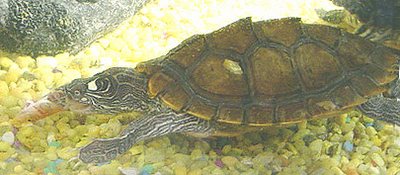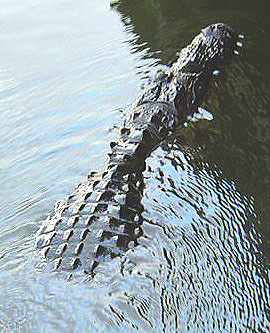 I have a Map Turtle that was purchased as a small baby (for educational purposes) and is now about five inches long. The serrated scales on the side of the shell are pretty cool. The Turtle also has a highly detailed skin featuring yellow stripes on her dark green skin. After the Mud Turtle died, we wanted to get another friend for the little red-ear slider. Small Mud & Musk Turtles are rarely available in the average Reptile store, and especially in the Fall months. So we found a baby Map Turtle, and he is getting along fine with the baby Red-Ear and the small Musk Turtle. One big happy family. That is a great thing about turtles. They usually get along very well, and they seem to live in harmony except when they are trying to get the same piece of food. They climb on each other to bask in the sunlight, and they do not seem to have any major hang-ups!
I have a Map Turtle that was purchased as a small baby (for educational purposes) and is now about five inches long. The serrated scales on the side of the shell are pretty cool. The Turtle also has a highly detailed skin featuring yellow stripes on her dark green skin. After the Mud Turtle died, we wanted to get another friend for the little red-ear slider. Small Mud & Musk Turtles are rarely available in the average Reptile store, and especially in the Fall months. So we found a baby Map Turtle, and he is getting along fine with the baby Red-Ear and the small Musk Turtle. One big happy family. That is a great thing about turtles. They usually get along very well, and they seem to live in harmony except when they are trying to get the same piece of food. They climb on each other to bask in the sunlight, and they do not seem to have any major hang-ups!
Wednesday, December 22, 2004
Map Turtle
 I have a Map Turtle that was purchased as a small baby (for educational purposes) and is now about five inches long. The serrated scales on the side of the shell are pretty cool. The Turtle also has a highly detailed skin featuring yellow stripes on her dark green skin. After the Mud Turtle died, we wanted to get another friend for the little red-ear slider. Small Mud & Musk Turtles are rarely available in the average Reptile store, and especially in the Fall months. So we found a baby Map Turtle, and he is getting along fine with the baby Red-Ear and the small Musk Turtle. One big happy family. That is a great thing about turtles. They usually get along very well, and they seem to live in harmony except when they are trying to get the same piece of food. They climb on each other to bask in the sunlight, and they do not seem to have any major hang-ups!
I have a Map Turtle that was purchased as a small baby (for educational purposes) and is now about five inches long. The serrated scales on the side of the shell are pretty cool. The Turtle also has a highly detailed skin featuring yellow stripes on her dark green skin. After the Mud Turtle died, we wanted to get another friend for the little red-ear slider. Small Mud & Musk Turtles are rarely available in the average Reptile store, and especially in the Fall months. So we found a baby Map Turtle, and he is getting along fine with the baby Red-Ear and the small Musk Turtle. One big happy family. That is a great thing about turtles. They usually get along very well, and they seem to live in harmony except when they are trying to get the same piece of food. They climb on each other to bask in the sunlight, and they do not seem to have any major hang-ups!
Thursday, December 16, 2004
Wednesday, December 15, 2004
Little Red Eared Slider
 We visited a local reptile pet store as we often do to look at the many interesting critters. I guess it is called window shopping. The usual suspects were there, incarcerated in their terrariums and aquariums, and some were in little plastic trays. The feeder rats, mice, pinkies, and bloods had just been delivered. You could see the big rats red eyes were looking for a way out as they scrambled around in their delivery crates.
We visited a local reptile pet store as we often do to look at the many interesting critters. I guess it is called window shopping. The usual suspects were there, incarcerated in their terrariums and aquariums, and some were in little plastic trays. The feeder rats, mice, pinkies, and bloods had just been delivered. You could see the big rats red eyes were looking for a way out as they scrambled around in their delivery crates. Spotted a batch of small red-eared sliders. These guys were very young and full of pep. The red-eared sliders were $5. each, the snapping turtles were $25. and the soft-shell, map turtles, and painted turtles were $20. each. Three of the turtles in our aquarium were now getting close to five inches long and they were purchased as little babies originally (for educational purposes).
Picked a very energetic little fellow. He/she is doing great so far, getting lots of sun and artificial lighting at the basking places in a long twenty gallon aquarium. Reptile aquariums are horizontally longer and vertically shorter.
Wednesday, December 01, 2004
Alligator hunting for snacks?
Releasing Turtles into the Wild
 Have you ever seen any animals kept in overcrowded conditions at a Pet Shop?? Most Pet Shops are very conscientious and try very hard to treat animals in a humane manner.
Have you ever seen any animals kept in overcrowded conditions at a Pet Shop?? Most Pet Shops are very conscientious and try very hard to treat animals in a humane manner. However, there are exceptions to every rule. But what can I do about it? A complaint to the Health Department might get some action. On the other hand, the Pet Store may be in compliance anyhow, or the overcrowded or unsanitary condition may have been resolved by the time it is investigated.
So if you could afford it, would you love to buy all the animals in stock and free them? For captive-born creatures like hamsters, snakes, dogs, cats, etc. it would be extremely deadly for the animals if they were just released at the local park.
But what about critters like Iguanas and Turtles?? You would think that if a bunch of large pet store stock turtles that were indiginous to the area were released back into a local lake that there could be no damage to the critters or the people?
It is a romantic notion to what to free animals that seem to be neglected, however most creatures lose their ability to compete in the wild once they have been living in a small aquarium or cage for a few months.
Once they lose a step, catching wild fish or other food may almost be impossible. So instead of liberating them from neglect, they become tourists in a wild environment where they do not belong. Either they slowly starve, or they get sick or they are eaten by faster and stronger wild creatures. So releasing our reptile friends back into the wild is not a responsible option.
The other possible repercussion is that turtles and other reptiles can pick up illnesses and parasites from other turtles and reptiles that they were penned together with. The cross-infecting of species is a major problem caused by the Pet Trade.
So if you release formerly captive reptiles into the wild, and they were infected with an illness that is native to another type of turtle or reptile, then that infection can spread to the local indiginous species of turtles or reptiles causing what amounts to be a plague. Therefore releasing captive animals is not good because the cure can be much worse than the problem.
The least likely possible repercussion is that you are caught in the act by a Game Warden or Forest Ranger. In most localities it is illegal to release any captive animal into the wild. So if you ever see a bunch of critters that you want to save from neglectful treatment, the only thing you can do is make space at your home and adopt one or two if you are sure that you can support them and are dedicated to giving them quality attention, care, housing, and food.
Subscribe to:
Posts (Atom)


